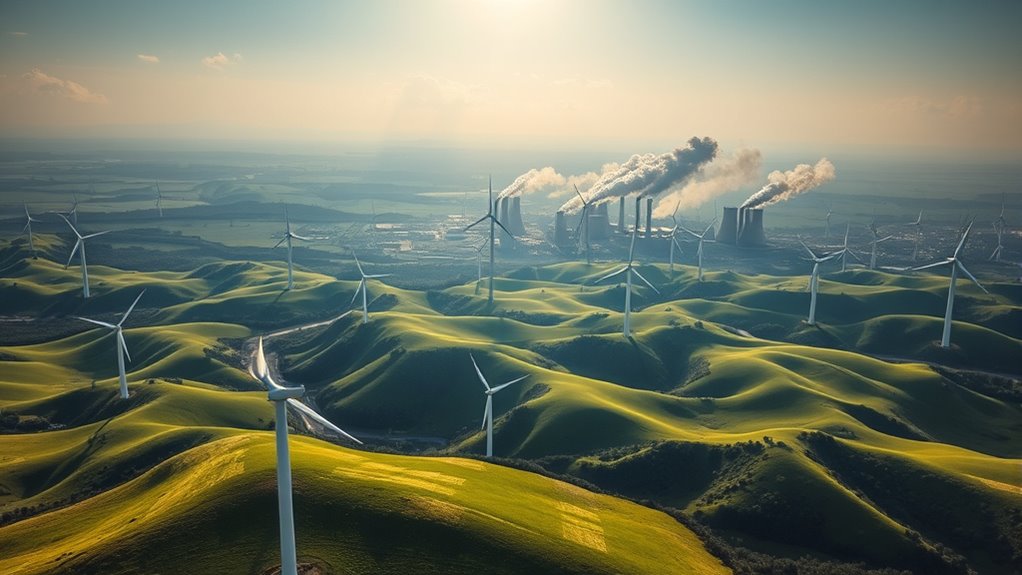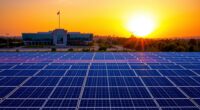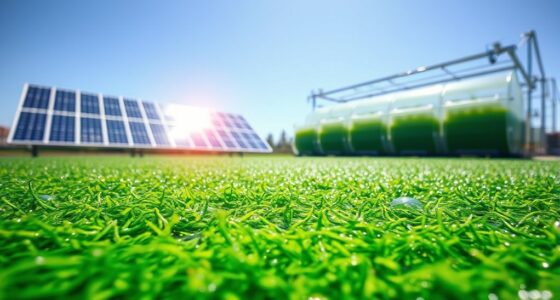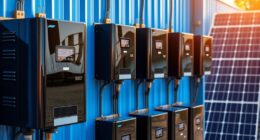Switching to 100% renewables presents challenges like storing intermittent power and upgrading aging grids to handle decentralized sources. You’ll need to overcome high costs for energy storage and build policies that encourage investments and innovation. Managing supply stability is vital, especially as renewables depend on weather. By addressing these hurdles carefully, you can help shape a sustainable future. Continue exploring to discover how these issues can be effectively tackled.
Key Takeaways
- Energy storage solutions are costly and complex, essential for managing renewable intermittency.
- Upgrading existing grids is necessary to handle decentralized renewable sources and ensure stability.
- Effective policy frameworks and investments are critical to facilitate renewable deployment and infrastructure modernization.
- Reliance on backup fossil fuel plants may persist due to renewable variability, impacting sustainability goals.
- Achieving 100% renewables requires integrated efforts, technological advancements, and long-term strategic planning.
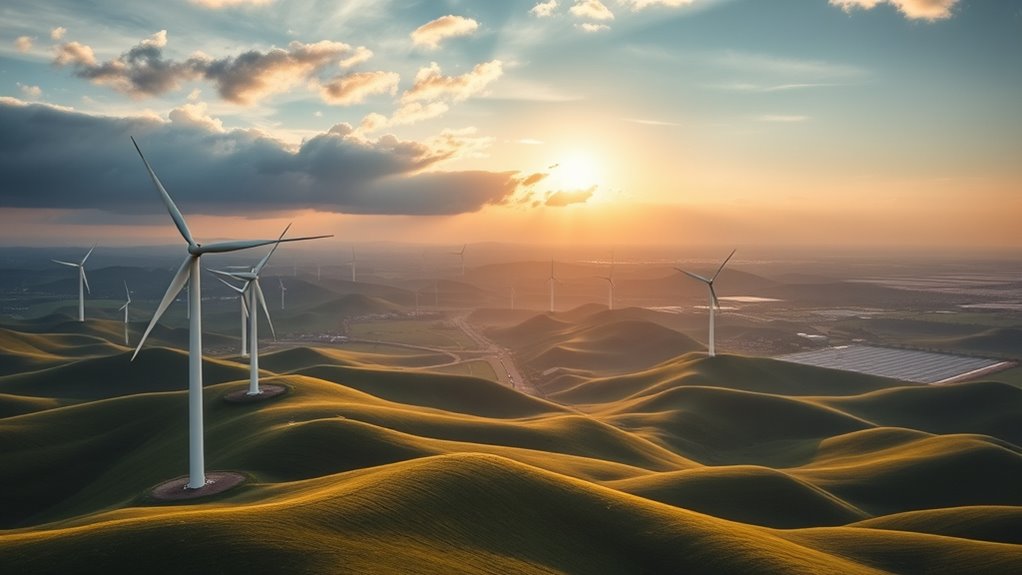
Are we truly prepared to shift from fossil fuels to renewable energy sources? This question lies at the heart of the global effort to combat climate change and build sustainable power systems. Transitioning to renewables like wind, solar, and hydropower offers immense promise, but it also presents significant challenges that can’t be ignored. One of the major hurdles is guaranteeing a reliable and consistent energy supply. Unlike fossil fuels, renewables are intermittent—they depend on weather conditions and time of day. That’s where energy storage becomes essential. You need effective ways to store excess energy generated during peak times so it can be used when production dips. Technologies such as batteries, pumped hydro, and thermal storage are advancing, but scaling them up remains a complex and costly task. Without robust energy storage, the grid could face instability, leading to power outages or the need for backup fossil fuel plants, which defeats the purpose of the transition.
Another key obstacle is grid modernization. Your existing electrical grid was designed for predictable, centralized power sources. Now, with a decentralized mix of wind turbines, solar panels on rooftops, and small-scale hydro, the grid must become smarter and more flexible. Modernization involves upgrading infrastructure, implementing advanced control systems, and integrating digital technologies that can handle variable inputs. This not only guarantees efficient distribution of clean energy but also enhances resilience against extreme weather events and cyber threats. Without a modernized grid, integrating high levels of renewable energy becomes inefficient and risky, limiting how much renewable power your system can handle.
You also need policies and investments to support this transformation. Transitioning isn’t just about installing renewables; it’s about rethinking entire energy systems. That requires collaboration across government, industry, and communities. Financial incentives, research funding, and regulatory frameworks are indispensable to accelerate deployment and innovation. As you work toward 100% renewable energy, understanding these interconnected challenges is essential. The path forward demands a proactive approach—investing in energy storage solutions, modernizing the grid, and fostering policies that facilitate a smooth transition. Only then can you guarantee that the shift away from fossil fuels isn’t just aspirational but achievable, reliable, and sustainable in the long run.
Frequently Asked Questions
How Will Grid Stability Be Maintained During Renewable Energy Surges?
During renewable energy surges, you’ll rely on grid balancing and surge management strategies to keep stability. You can use energy storage systems like batteries to absorb excess power and release it when needed. Demand response programs also help by adjusting consumption during peaks. Together, these methods guarantee your grid remains stable, even when renewable sources produce variable outputs, preventing outages and maintaining a reliable electricity supply.
What Are the Economic Impacts of Transitioning on Fossil Fuel-Dependent Communities?
You’ll likely face economic decline and job loss in communities dependent on fossil fuels as shifts occur. These areas often experience reduced employment opportunities and shrinking local economies. To address this, investments in retraining programs, economic diversification, and support for new industries can help. By actively engaging with affected communities, you can ease the economic impacts and promote a smoother transition toward renewable energy sources.
How Can Energy Storage Solutions Be Scaled Effectively?
You can scale energy storage solutions effectively by investing in advanced battery technology, which offers higher capacity and faster charging times. Focus on improving grid integration to guarantee storage systems work seamlessly with renewable sources, enhancing stability and reliability. By adopting these strategies, you’ll make renewable energy more dependable, encouraging wider adoption. This approach also helps balance supply and demand, making the shift smoother and more sustainable for the future.
What Policies Best Incentivize Renewable Energy Adoption?
Think of policies as the guiding compass for renewable energy’s journey. You should support carbon pricing to make fossil fuels less attractive, like a weight dragging down progress. Subsidy models act as fuel, energizing clean energy projects. By balancing these policies, you can create a powerful incentive for adoption, encouraging innovation and investment. Together, they steer us toward a sustainable future, making renewable energy more accessible and appealing.
How Will Intermittent Renewable Sources Meet Consistent Energy Demands?
You can meet consistent energy demands by relying on advanced energy forecasting and improved grid integration. Energy forecasting helps predict renewable outputs, allowing you to plan accordingly, while grid integration guarantees your energy system can smoothly manage fluctuations. By investing in storage solutions and flexible infrastructure, you’ll maintain stability and supply, even when renewable sources are intermittent. This approach makes your shift to renewable energy more reliable and sustainable.
Conclusion
As you stand on the brink of a cleaner future, imagine vast fields of solar panels stretching to the horizon and wind turbines dancing in the breeze. The path to 100% renewables isn’t easy, but every step you take helps clear the smoky skies and dark waters. Together, you can turn the tide, transforming our world into a vibrant, sustainable landscape where the air is pure, and energy flows freely, brightening every corner of tomorrow.
